

Inspiring Innovation. Stop just talking about 21st Century Skills, it time to be doing! Should I teach problem-, project-, or inquiry-based learning? SmartBlogs. Lately, there have been a bunch of buzzwords floating around the education world that all seem to mean the same thing.
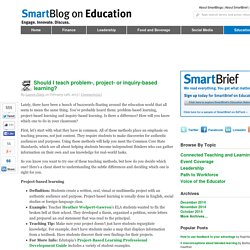
You’ve probably heard them: problem-based learning, project-based learning and inquiry-based learning. Is there a difference? How will you know which one to do in your classroom? First, let’s start with what they have in common. All of these methods place an emphasis on teaching process, not just content. So you know you want to try one of these teaching methods, but how do you decide which one?
Deeper Learning: Defining Twenty-First Century Literacy. Only a decade and a few years in, how can we fully describe the twenty-first century learner?
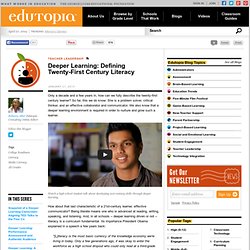
So far, this we do know: She is a problem solver, critical thinker, and an effective collaborator and communicator. We also know that a deeper learning environment is required in order to nurture and grow such a learner. Watch a high school student talk about developing 21st-century skills through deeper learning. How about that last characteristic of a 21st-century learner, effective communicator? Being literate means one who is advanced at reading, writing, speaking, and listening.
"[L]iteracy is the most basic currency of the knowledge economy we're living in today. In today's world, being literate requires much, much more than the traditional literacy of yesterday. In the Classroom When it comes to effective communicator, we can no longer consider college and career ready as simply sending students out as good readers and writers. Gain proficiency with tools of technology.
Educational Technology and Mobile Learning: Top 10 Videos on 21st Century Learning. 1- Expanded Learning Opportunities 2- What is 21st Century Education 3- Educate The Heart.
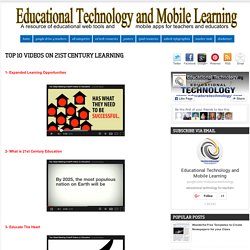
8 Things to Look For in Today’s Classroom. As I think that leaders should be able to describe what they are looking for in schools I have thought of eight things that I really want to see in today’s classroom.

I really believe that classrooms need to be learner focused. This is not simply that students are creating but that they are also having opportunities to follow their interests and explore passions.1 The teacher should embody learning as well. Will Richardson recently wrote this in a comment on one of my recent posts on what teachers need to be like in our current day and the focus that needs to be on learning: …we need teachers who are masters at developing kids as learners who are adept at sense making around their own goals. Teachers who are focused on helping students develop the dispositions and literacies required to succeed regardless of subject or content or curriculumThis moment is all about learners having an amazing new freedom to learn, not teachers having an amazing new freedom to teach. 1.
Three Trends That Define the Future of Teaching and Learning. Culture Digital Tools Teaching Strategies.
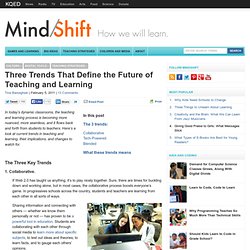
Teaching Skills: What 21st Century Educators Need To Learn To Survive. What are the traits that would make for the ideal 21st teacher?
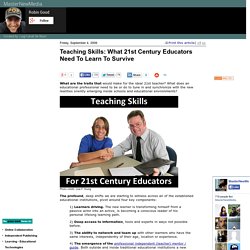
What does an educational professional need to be or do to tune in and synchronize with the new realities silently emerging inside schools and educational environments? Photo credit: Lisa F. Young The profound, deep shifts we are starting to witness across all of the established educational institutions, pivot around four key components: 1) Learners driving. These new "teachers" think, act and perform their multiple roles of guides, facilitators and learning advisers with a spirit and attitude that is radically different from the one that is typical of the traditional, classic educator. Andrew Churches challenges the status quo and paints a detailed profile of what this new breed of professors is going to look like.
Eight Habits of Highly Effective 21st Century Teachers By Andrew Churches. SixHabitudes - What are The Habitudes? Ken Kay. 21 Century Info. Framework for 21st Century Learning. P21's Framework for 21st Century Learning was developed with input from teachers, education experts, and business leaders to define and illustrate the skills and knowledge students need to succeed in work, life and citizenship, as well as the support systems necessary for 21st century learning outcomes.
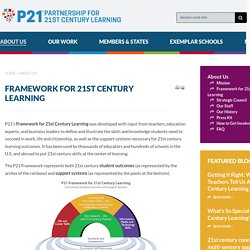
It has been used by thousands of educators and hundreds of schools in the U.S. and abroad to put 21st century skills at the center of learning. The P21 Framework represents both 21st century student outcomes (as represented by the arches of the rainbow) and support systems (as represented by the pools at the bottom). While the graphic represents each element distinctly for descriptive purposes, P21 views all the components as fully interconnected in the process of 21st century teaching and learning.
21st Century Schools or 21st Century Learning? Even this picture is way too old…We need to start having focused conversations on this topic.

Personalization and Responsibility. George Siemens wrote the Duplication theory of educational value about higher education, but I am going to share a quote from this with a couple adaptations for K-12 public education: “Let me posit a duplication theory of education value: if something can be duplicated with limited costs, it can’t serve as a value point for [public education].
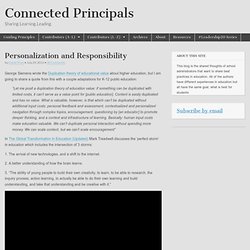
Content is easily duplicated and has no value. What is valuable, however, is that which can’t be duplicated without additional input costs: personal feedback and assessment, contextualized and personalized navigation through complex topics, encouragement, questioning by [an educator] to promote deeper thinking, and a context and infrastructure of learning. Basically: human input costs make education valuable. We can’t duplicate personal interaction without spending more money.
In The Global Transformation in Education (Updated) Mark Treadwell discusses the ‘perfect storm’ in education which includes the intersection of 3 storms: 1. 2. 3. What a classroom will look like in 10 years. Technology is rapidly evolving.

This evolution is occurring because people are sharing ideas, resources and themselves online 24/7. So what does this mean for our education? Education has long been seen as a vertical un-adaptive to change. Fifty years ago schools had individual desks, a blackboard in the front of the room and a teacher who administered lessons and testing in accordance to their specific state. Today, schools have individual desks, Smartboards instead of blackboards and a teacher who administers lessons and testing in accordance to their specific state. Although some schools are slower than others to adapt technology changes, that doesn’t mean others are not jumping in feet first and utilizing the open source way to change education as we know it. 21st Century Pedagogy. Even if you have a 21st Century classroom(flexible and adaptable); even if you are a 21st Century teacher ; (an adaptor, a communicator, a leader and a learner, a visionary and a model, a collaborator and risk taker) even if your curriculum reflects the new paradigm and you have the facilities and resources that could enable 21st century learning – you will only be a 21st century teacher if how you teach changes as well.
Your pedagogy must also change. Definition: pedagogy - noun the profession, science, or theory of teaching. Source: Key features How we teach must reflect how our students learn. Knowledge Knowledge does not specifically appear in the above diagram. We need to teach knowledge or content in context with the tasks and activities the students are undertaking. Thinking skills Thinking Skills are a key area. Study: '21st-Century Learning' Demands Mix of Abilities - Inside School Research. Ed Leadership Articles.